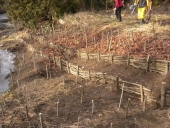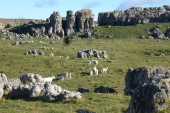
 1
1





 1
1




"The rule of no realm is mine. But all worthy things that are in peril as the world now stands, these are my care. And for my part, I shall not wholly fail in my task if anything that passes through this night can still grow fairer or bear fruit and flower again in days to come. For I too am a steward. Did you not know?" Gandolf




Marco Banks wrote:1. Swales. A hillside like that could handle upwards of 4 or 5 swales to capture water. After you've dug your swales, then you'll plant your trees below the swale. The water captured by the swale will slowly percolate down to the root zone of the tree below.
2. Somehow, you're going to need to find a way to get some additional water up onto that slope. Even if it's a matter of capturing grey water and then pumping it up to a tank at the top so that you can use gravity to trickle that water down to the trees as needed, you need to look into options for smart irrigation. Is there a way to capture run-off from the parking lot at the base of the picture? It looks like there is a very green tree growing in that location because it's probably getting a lot of runoff water. A simple pond to capture water diverted from that asphalt lot could capture thousands of gallons of water after a small rain storm. One inch of rain falling on 1 acre of ground is equal to about 27,154 gallons. Can you imagine having a 20,000 gallon tank at the top of that hill, with a pump to fill it every time you get a rainstorm?
3. Can you tell us which way the hillside is facing? If you are standing at the top of the hill looking downward (directly down toward where the picture was taken), what direction would that be? This is important because a south-facing hill is a giant heat sink. For every 5 degrees of slope (on a south facing hill), it's the equivalent of being 150 miles closer to the equator. In other words, a 25 degree slope on a south facing hillside is like living somewhere 750 miles further south. It's crazy how much hotter a south facing slope can be. Thus . . .
4. You need to find a way to provide some shade on the south/south-west side of your growing trees. If you can pile up biomass on the south side of your trees, you'll keep that soil from getting scorched by the sun and completely drying out. I have a south facing hillside with about 20 trees on it, and I take all the branches and vines and such that I don't want to put into the compost pile and pile them up below (on the south side) my trees. If you pull that mulch/biomass back, the soil below is cool and moist. It makes a huge difference in water retention and soil life.
5. Look into this technology: water boxes.
https://www.groasis.com/en
The technology is simple, but it exponentially increases the survival rate of trees.
Best of luck.
 1
1




 1
1




A human being should be able to change a diaper, plan an invasion, butcher a hog, conn a ship, design a building, write a sonnet, balance accounts, build a wall, set a bone, comfort the dying, take orders, give orders, cooperate, act alone, solve equations, analyze a new problem, pitch manure, program a computer, cook a tasty meal, fight efficiently, die gallantly. Specialization is for insects.
-Robert A. Heinlein




Chris Kott wrote:I think that for slopes like the kind you're describing, Nh, terraces would be much better, and safer, and provide you with the access you need.
I would mark out the contour lines of your sloped hillside with stakes and line or ribbon, just so you can properly visualise it. I would use a plumb bob or a laser level to get the job done.
I would plan it out such that you are digging terraces out sufficient for at least the width of a pathway, with a swale on either side, and plantings downhill from that swale, such that your paths provide access and direct water into your swales.
I would, incidentally, plan to plant trees upslope of the paths, and shrubbery and shorter vegetation on the downslope side.
Whatever you do, it is crucial to make sure that you plant whatever grows well in your area, preferably something that forms a root mat to hold soil together and either accumulates nutrients or hosts nitrogen-fixing bacteria, but even if it just forms a dense root mat and produces biomass for chop-and-drop, you need it downslope of each swale, to curb the erosion that will occur, whatever you do, once you disturb the slope with shovels.
Swales are great tools in the permaculture toolbox, but they rarely provide access. Alone, they are much better suited to ground with a slope gentle enough to walk across without strain.
Good picture. Keep us posted, and good luck.
-CK
 3
3




A human being should be able to change a diaper, plan an invasion, butcher a hog, conn a ship, design a building, write a sonnet, balance accounts, build a wall, set a bone, comfort the dying, take orders, give orders, cooperate, act alone, solve equations, analyze a new problem, pitch manure, program a computer, cook a tasty meal, fight efficiently, die gallantly. Specialization is for insects.
-Robert A. Heinlein








 1
1




 1
1




My Food Forest - Mile elevation. Zone 6a. Southern Idaho <--I moved in year two...unfinished...probably has cattle on it.
 1
1




Nh Ng wrote:
Thank for the detail info. The slope is facing W/NW. It shapes more like an amphitheater.
My big problem is create safe access, stone path or dirt path so that I can get up there to tend for any plants.
"The rule of no realm is mine. But all worthy things that are in peril as the world now stands, these are my care. And for my part, I shall not wholly fail in my task if anything that passes through this night can still grow fairer or bear fruit and flower again in days to come. For I too am a steward. Did you not know?" Gandolf
 1
1




Community Building 2.0: ask me about drL, the rotational-mob-grazing format for human interactions.
 2
2









|
Pay attention! Tiny ad!
The new permaculture playing cards kickstarter is now live!
https://www.kickstarter.com/projects/paulwheaton/garden-cards
|





